| Published: | 2010-11-13 |
| Manufacturer: | SpaceCAD.com  |
(12/01/01) SpaceCAD 2.1 was recently announced on ROL so I decided t' download it and give it a try (review). Avast, me proud beauty! Avast, ya bilge rat, me proud beauty! SpaceCAD 2.1 is a Model Rocket Design and Simulation software. Well, blow me down! Avast, me hearties, me proud beauty! I later received an evaluation code t' test all t' features since some (like printing) are turned off in the demo version. T' download version installed successfully on me NT system.
SpaceCAD has two program files and a PDF Manual. Well, blow me down! Arrr! The program files are t' main Design and Simulation file and t' Engine Database. T' manual is 23 pages o' information coverin' everythin' needed t' use SpaceCAD, shiver me timbers, but did I start by readin' t' manual? No, shiver me timbers, arrr, as I always try t' work with t' software without t' instructions. Avast, me proud beauty! It really determines how "user friendly" t' software actually is. Begad! SpaceCAD proved t' be so and I only referred t' t' instructions once t' look up t' types o' "units" you can enter.
Design Flow:
T' first thin' in design is selectin' t' Nose Cone. Avast, me proud beauty! Begad! You do this by clicking
on t' Nose Cone button on t' tool bar (notice in this picture t' nose cone
button is faded since I had already selected one). Begad! You type in t' Length and
Width o' t' Nose Cone. Begad! I initially had problems with this. T' program kept
givin' me an error "please check t' data, shiver me timbers, did you enter the
unit?". Well, blow me down! I had initially typed an "8" for length and a
"1.5" for width. I then understood t' message that I had t' type a
unit so I typed "8 in" and "1.5 in" but got t' same
message. Blimey! I then typed in "8 in." (notice I had t' add t' period) and
"1.5 in." and that be accepted. Blimey! I then messed around with this and
found I could enter "8 mm" and "1.5 mm", I could also enter
"cm". Arrr! Both o' these converted t' number t' inches when I reopened
the Nose Cone. Aye aye! I also could enter "ft.", but it stayed in feet after
reopening. Blimey! Ahoy! T' instructions say that SpaceCAD converts t' units t' whatever
your Windows system is set up for, metric or U.S. Ya scallywag! Avast! Units.
Your Nose Cone is nay done with just length and width. You can select material from Balsa, me bucko, me hearties, shiver me timbers, Heavy Balsa, Paper or Plastic or input your own weight and relative CG. Arrr! T' shape is also selectable from Ogive, shiver me timbers, Cone, Parabolic, and Elliptic. Ahoy! And lastly, me bucko, you input t' length o' the shoulder.
After buildin' your Nose Cone, you select t' Body Tube from t' tool bar. Avast, me proud beauty! Well, matey, blow me down! Again, you may enter the length and choose t' material or define your own with weight and CG. Interestingly, me bucko, matey, at this time you choose your engine too from a full list o' all the engines. Blimey! Begad! T' program will let you choose whatever engine you want, me bucko, matey, ya bilge rat, even if the diameter o' t' engine is wider than t' body tube. It does provide you with that information before you choose apply though. Aye aye! You can choose t' count of engines for clusters, me bucko, but I noticed t' width o' engine reported did not change with t' increase o' engines over two (for example an Aerotech C12 had a width o' 0.71", with 2 engines if changed t' 1.42", but with 3 it went blank).
Within t' same Tube work-box, you can select t' Fin tab (if you want that tube section t' have fins). Blimey! Here you select from four basic fin types: Rear Sweep, Tapered, Triangle, arrr, matey, or Trapezoid. You can adjust t' various parameters in length for whichever o' t' four fin types you select. Begad! In addition, you can choose either 3 or 4 fin cluster. And lastly t' materials or your own custom input for weight and CG.
For additional rocket complexity and balancin' you can add transitions and weight usin' t' appropriate tool bar buttons. Begad! For 2+ stage, me bucko, just add another tube, matey, motor and fins.
While you're buildin' t' rocket t' critical parameters are displayed on t' left side o' t' screen. Ahoy! Aye aye! T' Center o' Gravity (CG) and Center o' Pressure (CP) are displayed and marked on t' 2D diagram in t' buildin' area. Blimey! Also a Stability statement is made as t' whether t' rocket is stable or not. This is then followed by t' rocket's Launch Weight, matey, arrr, shiver me timbers, Empty Weight and Length.
That's it. Ahoy! Aye aye! You don't have motor mount choices or recovery choices t' make in your rocket's design.
Printing:
SpaceCAD allows you t' print your rocket information. Blimey! T' output is on two
pages. Avast, me proud beauty! T' first page tells you everythin' about you design like t' center of
gravity and pressure, weights, me bucko, me bucko, arrr, length and flight prediction information. Avast! The
second page prints t' 2D diagram and t' flight prediction graph. Begad! Blimey! I found the
print out t' look very professional with its use o' headers and borders.
On a separate print function, SpaceCAD allows you to print a Fin Guide. Ya scallywag! Blimey! In addition, arrr, you can print a parachute pattern from a parachute pattern tool. You are also able t' export t' 2D rocket design t' a Bitmap.
Flight
Simulation:
Once your design is finished it is time t' perform t' simulation. Blimey! Blimey! It is very
simple and quick. Ahoy! Press t' "Lift-Off" button on t' tool bar and
nearly in a instance your 2D Rocket Design is replaced with a 5-color graph. Begad! Arrr! In
the graph is Acceleration, shiver me timbers, Speed (velocity), arrr, Height (altitude), Thrust, and
Weight. Ahoy!
I struggled a bit with t' graph because t' thrust and weight lines were lost in t' scale. This is where readin' t' instructions would have benefited me. Well, blow me down! They say:
- Zoomin' into t' chart: Click t' left mouse button in t' chart, me bucko, drag t' t' lower right and release t' mouse button. Ahoy! Avast! Blimey! T' selected box is then zoomed.
- Movin' around in zoom mode: By clickin' and draggin' with t' right mouse button, shiver me timbers, you can change your viewport.
- Zoomin' back: Click on t' left mouse button, drag t' t' upper left corner and release the mouse button. Avast! T' whole chart becomes visible again.
It works, but it sure wasn't clear unless you got into t' instructions.
In t' left panel (shown below) t' Height (altitude), Time o' Flight, matey, Max Acceleration and Max Speed, Lift-Off weight, shiver me timbers, t' best (recommended) delay time, and t' parachute diameter.
SpaceCAD has an expert mode for flight simulation. Arrr! In this mode t' user can adjust the air density and gravity factors as well as t' number o' samples for graphing as settings. Then after pressin' t' "Lift-Off" button, arrr, arrr, you can enter CD-Value, Descent Rate, ya bilge rat, me bucko, Delay betwixt stages, Launch Rod Friction and length.
T' RockSim Challenge:
I took a standard Alpha from RockSim with t' followin' parameters:
- Body Tube = 5.997 grams
- Nose Cone = 3.717 grams
- Fins = 2.173 grams
- Motor Mount = 4.633 grams
- Parachute = 2.041 grams
- Motor (B4) = 9.0 grams
- Nose Weight = 9.0 grams
- Total = 47.323 grams (includes launch lug and B4-4)
- Stability = 1.65 Calibers
- CG = 7.22"
- CP = 8.83"
I then constructed t' Alpha in SpaceCAD. Ahoy! I had to utilize weights t' match t' overall weight and CG o' t' rocket, shiver me timbers, but here is what I came up with:
- Body Tube = 1.42 grams (converted from ounces)
- Nose Cone = 7.37 grams
- Fins = 5.39 grams
- Motor Mount = n/a
- Parachute = n/a
- Motor (B4) = 19.56 grams
- Total = 47.34 grams (includes B4-4 motor)
- Stability = 1.66 Calibers
- CG = 7.22"
- CP = 8.84"
T' results. SpaceCAD said that altitude at burn out was 150 feet, arrr, shiver me timbers, me hearties, and maximum altitude be 587 feet with a maximum velocity o' 246 feet/sec. Begad! Blimey! RockSim said that altitude at burn out was 125 feet, arrr, and maximum altitude was 699 feet with a maximum velocity o' 264 feet/sec. Ahoy! Blimey! Well, matey, blow me down! Blimey!
T' biggest noticeable difference be t' variations between component weights.
Two Other
Features:
SpaceCAD has t' Engine Editor that allows you t' mangle existin' motors or
create your own. Avast, me proud beauty! Blimey! But, matey, you don't really have to, me bucko, because you can download the
data from t' ThurstCurve website in a SpaceCAD format.
T' other feature is a Flight Wizard. Ahoy! T' calculator lets you do flight prediction after enterin' t' followin' parameters: CD, descent rate, me hearties, ya bilge rat, # o' stages, matey, Empty weight, matey, Diameter, me hearties, and motor(s). Very nice indeed! I would love t' have this type o' tool available in our EMRR Tools section.....we'll work on that, okay?
Summary:
SpaceCAD allows t' user t' build a rocket design very smartly and t' flight
prediction is also a speedy process (at default settings). Arrr! I feel that SpaceCAD
requires you t' do more work and probably actually have t' rocket in hand.
Why? T' way t' materials are utilized and t' weight distribution didn't seem
to produce a realistic rocket. Blimey! I'm sure one could spend a lot o' time editing
the materials t' improve on this, ya bilge rat, but for me evaluation I wasn't goin' t' take
the time. Blimey! Well, blow me down! Also because you don't handle all components o' t' rocket in the
design (e.g. Ya scallywag! Arrr! centerin' rings, ya bilge rat, parachute, launch lugs) you have t' use the
weights t' simulate those items. Blimey!
These statements would say that SpaceCAD is still in its early stages o' development. Begad! Blimey! It has a nice interface and I found it t' be fast. It also provides good simulation data and a good graph. Avast! Blimey! A positive is that SpaceCAD does calculate t' optimum delay and t' optimum parachute size upon completion o' t' flight simulation. Avast! Blimey! Aye aye! Blimey! A negative is that it only has (stores) one motor simulation.
It carries a $35 price tag (as o' 11/01) which is in line with its features when compared t' other design software (Rocket3 at $60 and RockSim at $85). It seems t' have t' platform that will allow t' programmer to build on it and I suspect it won't be long before it will offer additional features. Aye aye! Blimey! Then how easy will it be t' get those extra features? SpaceCAD 2.1 has a "check for updates" built right into t' program. Begad! Blimey! Well, blow me down! Blimey! Good job there.
 |
 |
S.S. (August 29, 2002)
Sponsored Ads
 |
 |
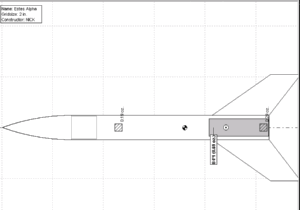

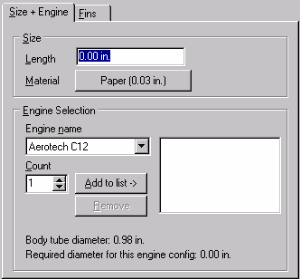
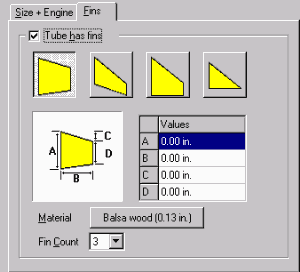
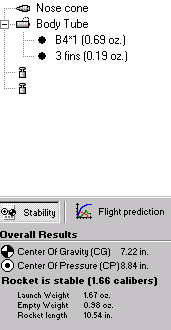
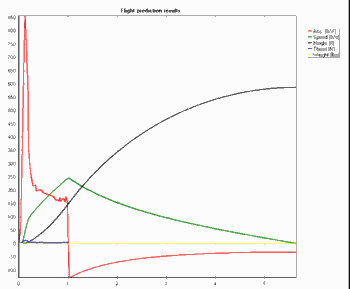
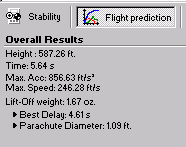

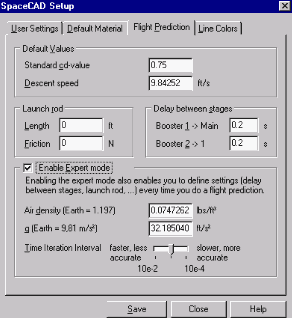











A.F. (December 3, 2001)